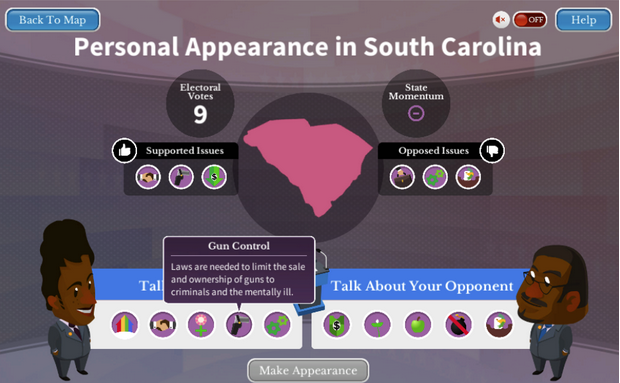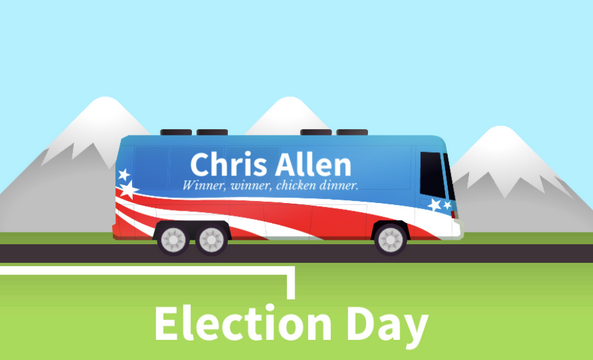Win the White House must be the only educational game in history to reference gun control, chicken dinners and gay marriage within the first 5 minutes of gameplay, and, with so many people focused on this year’s presidential campaign, it also recently had a facelift.

Win the White House offers students a Common Core-aligned civics game.
Educational non-profit iCivics launched a “re-do” of Win the White House in March designed to take advantage of both the 2016 fireworks and some enhanced character customization options for players. iCivics originally release presidential campaign simulator in 2012.
“It’s a magical time to be re-releasing a game about the elections,” said iCivics Director of Content Carrie Ray-Hill during a Filament Games podcast.
Ray-Hill first worked on Win The White House’s development after joining the iCivics crew in 2012, and is also a former civics teacher.
“I think teaching around the elections is super important, so both the content is critical and it’s hard enough to make you want to keep playing. Before you just picked an avatar…but now you get a slogan of your choice, you do your vice presidential candidate pick, you pick a home state that you’re from, and there’s a lot more investment in your character, which is never bad for games,” she said.
Aligned with both state and Common Core standards, Win the White House shares room in the iCivics stable with nearly 20 other educational games, many of which were designed by the industry stalwarts at Filament Games.
In a recent interview with The New York Times, retired Supreme Court justice Sandra Day O’Connor, who founded the civic education non-profit, hailed iCivics’ suite of games for their ability to connect with students and helps motivate them to look at their own problems.
“iCivics has been an effective way to reach young people, and to give them an enhanced capacity to have critical thinking of their own. How to look at problems that they care about. To learn that, to think it through, and figure out how to get a solution to what they care about is a great thing to learn when you’re young. And then to carry it out is thrilling,” the 86-year-old retired associate justice said.
A student or a teacher can create their own Republican or Democratic candidate, select from 5 issues traditionally associated with their party — including one chance to go “maverick” and chose to support an issue outside the traditional party line — and win their party’s primary.
Should guns be legal for everyone or prohibited to those with criminal records or a history of mental illness? Should abortion be outlawed or should women retain the right to chose? Heady stuff.
Depending on the level of difficulty — elementary, middle school or high school — players must not only select answers that demonstrate your basic understanding of the issues, but give rationales for why they chose them. Win the White House presents these issues in a brief but surprisingly honest way that doesn’t dumb down the content for the kids.
Each turn, players must raise money by fundraising in a state in which their selected party is leading in the polls. With the the fresh cash, they can choose to either poll an additional state to see how they’re faring or increase their political momentum with a media ad or an in-person speech in a state in a previously polled state.
iCivics reports that teachers from all 50 states are using at least one iCivics game in their classroom, and roughly half of them use Win The White House, including educator and author Matthew Farber, who recently introduced the game to his 7-grade class in New Jersey.
“Something interesting happened,” Farber told gamesandlearning.org, “They asked to play again the next day. Students wanted to switch up their strategies. The game isn’t easy to win and they wanted to play more.”
Farber recently published Gamify Your Classroom: A Field Guide to Game-Based Learning, and believes the more his students played, the more they learned.
“The game is coded in such a way that players are not rewarded for being disrespectful to another candidate, or for making inflammatory remarks. Going beyond the race for the presidency, the game also teaches civic values and dispositions,” he said.
Players only have 10 turns to raise money and win votes in states, so an average playthrough won’t give players enough time to poll more than about half the states, making big time states like New York, California, Texas and Florida with the massive amount of electoral votes crucial to winning. But Win the White House doesn’t seem like it’s meant to be a hyper realistic political simulator. The idea is to get students familiar with social issues.

Chris Allen’s campaign bus on the trail.
Player can also select and print out bumper sticker and T-shirt designs complete with their campaign slogans. The choices range from classic, Putting Our Country First!, to comical,“Winner Winner chicken dinner,” but only affect the words plastered on the side of the election tour bus.
Each state will have issues its residents either “support” or “oppose,” so a candidate who chooses to support gay marriage or gun rights won’t find much traction in a state that opposes those measures, in which case, they may have to resort to a negative campaign to boost political support, which is how the players wins the state’s electoral votes. This poses an interesting choice for the player, since they’ve have to actively choose whether to play dirty to get votes, or stay classy but risk losing the game.
At the very least, kids will will come out of Win the White House will a better understanding of how the electoral college works, and a deeper understanding of why presidential candidates skip over their town to curry favor in bigger states on their quest for 270 electoral and the Oval Office.
